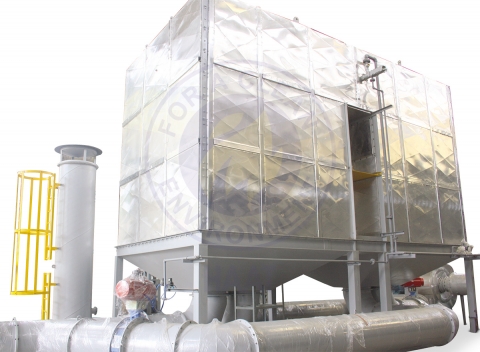
The Manufacture of a Regenerative Thermal Oxidiser
The Regenerative Thermal Oxidiser, RTO for short, is really essential pollution control equipment for industries producing VOC containing waste process gas/air, as it helps to clean the gas/air and release cleaner air to the atmosphere.
Haat has been making both DFTOs (Direct Fired Thermal Oxidisers) and RTOs and has supplied these to many industries within the country and abroad.
These RTOs run mostly 24 x 7 depending on the process plant timings, as these are linked to the process. It is, therefore, essential that the RTO which is part of the process should also run along with the process plant without interruption.
While making an RTO, we need to give importance not only to the quality of the manufactured items, but to also make efforts to choose very carefully certain outsourced items for their quality and performance, because these items are key to the efficient functioning of the RTO.
We are highlighting here some of these components / sub-assemblies, their functions and the important role they play in making the RTO run uninterruptedly and satisfactorily:
• Honeycomb ceramic filters: This is a simple component but difficult to make because it contains 1600 tiny apertures in an area of 150 x 150 mm. Each filter is 300 mm long and hence these apertures have to be straight from one end to the other. Imagine a small ceramic block which is hard and brittle and which has 1600 small holes running straight thru the entire length. It is very difficult to make. We tried to source it from within the country but no one in the ceramic industry was able to achieve a length of 300 mm with so many tiny holes. We had to necessarily look for this product outside the country and succeeded in sourcing it from a Far Eastern country. We have used this product many times from this source and find it to be of very good quality. We never had an occasion to replace it at any of our installations so far.
• What is the function of this component?: In an RTO, the waste gas containing VOCs is burnt in a combustion chamber, after which they pass through the filter bids. The filter bed consisting of hundreds of these filters absorbs the heat and when hot enough, beds are switched and the hot bed pre-heats the incoming gas stream. In many cases, once ignited, there is no need for any additional fuel for running the RTO. The system becomes self-sustaining and is very economical in terms of running costs.
• Butterfly valves with actuators: This is another vital part of the RTO. The number of valves depend on the process and control philosophy, but the main purpose of this component is to open and close, at pre-determined intervals, the ducts carrying dirty gas and clean gas as they come into the RTO and leave the RTO, in such a way that it takes no more than 1.5 seconds to open and close. This is very important as we do not want any dirty gas to be released into the atmosphere. Although the requirement is 1.5 seconds, we achieve a timing of 0.8 seconds, which makes the RTO a very reliable piece of equipment when it comes to emissions.
• Igniter: As opposed to a monoblock burner that is normally used in an incinerator, an igniter is used in an RTO. It has independent fuel delivery and independent combustion air supply. The igniter is constantly cooled by a fan to prevent damage to it. Ignitors are the most versatile devices to ignite oil or gas. They work on the principle of producing a low energy spark between two electrodes by passing a high voltage current of a few mili amperes for ignition. Igniters receive a signal when there is a call for heat. They achieve superior flame ignition and flame stability with low opacity. The ignitors also support the system in the event of unstable temperature conditions due to lower VOC content in the gas.
There are, of course, other components / sub-assemblies in an RTO, but we thought we should bring out the most critical ones, to show the role they play in ensuring CONTINUOUS AND SATISFACTORY PERFORMANCE OF AN RTO.


